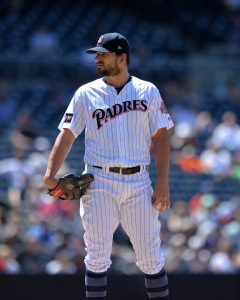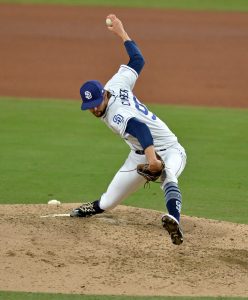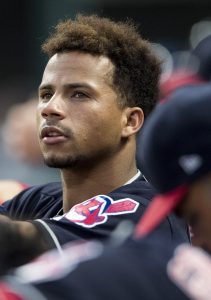The Indians didn’t leave themselves much margin for error heading into the 2019 campaign. Ownership mandated payroll cuts in the offseason while delivering a candid and ominous “enjoy him” message to fans in reference to franchise shortstop Francisco Lindor. Cleveland’s Opening Day lineup looked more like the type you’d expect to see in early Spring Training than that of a division favorite earnestly putting forth its best options. An injury to Lindor weakened the product, but the holes throughout an order that featured Tyler Naquin hitting third were glaring.
A questionable offense was a known trade-off, though, as the Indians were built on the foundation of perhaps the game’s best collection of starting pitchers. Two-time Cy Young winner Corey Kluber was again joined by co-aces Carlos Carrasco and Trevor Bauer, while younger righties Mike Clevinger and Shane Bieber rounded out a rotation that would make nearly any team envious.
Fast forward a bit more than 10 weeks, and only Bauer and Bieber are healthy — neither with the results one might’ve expected of them. Clevinger made two starts before going down to a teres major strain that still has him on the injured list (though he’s nearing a return). Kluber suffered a fractured arm when he was struck by a comebacker. Most concerning of all, Carrasco is on the injured list due to a blood condition that has rendered him lethargic and likely contributed to some disappointing on-field results of his own. Even the Indians’ top depth option, Jefry Rodriguez, landed on the IL last week.
The result is an Indians club that trails the surprising Twins by 10.5 games in the AL Central. At 33-32, the Indians are still within 1.5 games of the second AL Wild Card spot, but it’s a tight race. Both the Yankees and the Rays are at 40-24, jostling for the AL East division lead. They’re six games up on another surprising club, the Rangers, and one of New York or Tampa Bay appears quite likely to claim that top Wild Card position. The Red Sox, Indians, Athletics, White Sox and Angels are all within four games of Texas for that second spot. Each of the Rangers, Red Sox and Athletics rather handily tops Cleveland’s -6 run differential.
The Indians are clear Wild Card contenders with a (much) longer shot to fight back into the division race, but for a club that entered the year as a strong favorite in the AL Central, their outlook is unexpectedly bleak. And given the obvious payroll constraints they faced in the offseason, it’s worth questioning whether ownership will dub the 2019 campaign somewhat of a transitional year and look to further cut some costs.
The Indians have just $48.4MM committed to next year’s payroll (via Jason Martinez of Roster Resource). That seems plenty manageable, but the number won’t stay at that level. Kluber’s $17.5MM option seems likely to be exercised even with his injury and some unexpected struggles (5.80 ERA in 35 2/3 innings). Lindor and Bauer headline an expensive arbitration class. Lindor already received a $10.55MM salary in his first trip through the process, and while we can’t know precisely what he’ll earn, last year’s Kris Bryant and Mookie Betts cases provide somewhat of a range. Both players earned similar numbers to Lindor in their first arbitration campaigns; Bryant had an injury-hindered year in 2018 and was bumped up to $12.9MM while Betts won the AL MVP and vaulted to $20MM. Lindor will probably check in somewhere near the midpoint — perhaps closer to Betts given that he’s been quite productive since returning from the IL. Bauer, meanwhile, will get a raise on a $13MM salary and could approach the $20MM mark.
The aforementioned $48.4MM figure could balloon to the $100MM vicinity when accounting for the salaries of Lindor, Kluber and Bauer alone. Add Clevinger’s first arbitration salary, the need to supplement the roster in other areas (one of second/third base, the bullpen, the outfield) and several league-minimum players, and it’s easy to see the payroll approaching or even exceeding the current $124MM mark despite a drop in attendance from 2018. All of this is to say that the Indians enter the summer not as the clear-cut buyers that many anticipated but as a team that could plausibly walk the line between a sell-off and some measured upgrades to the roster.
Players like Bauer and Brad Hand will be highly attractive assets who could command sizable returns. Cleveland knows it won’t sign Bauer long-term. The right-hander has been open on multiple occasions about his plans to play out his career on a series of one-year contracts (thus maximizing his salary on a year-over-year basis while also incurring a good bit of risk).
Hand is controlled through 2021 ($7.6MM in 2020, $10MM club option in 2021), and every contender in the game would love the opportunity to add him to its bullpen. His value right now is arguably as high as it was when the Indians acquired him a year ago; Hand has career-bests in ERA (0.98), FIP (1.70), xFIP (2.82) and HR/9 (0.33) at the moment and is eminently affordable. ESPN’s Buster Olney wrote yesterday (subscription required) after chatting with executives around the league that other teams expect Cleveland to trade Hand with his value nearing its apex.
Moving Hand or Bauer wouldn’t do the Indians’ playoff chances any favors, but doing so could yield controllable, near-MLB-ready talent while simultaneously providing the front office with a substantial increase in payroll flexibility this winter — dollars that could be reallocated to putting forth a more complete roster. And selling either or both players wouldn’t totally eliminate the team from contention, given the rather mediocre nature of the AL Wild Card race at the moment and the rebuilding nature of the bottom of the AL Central. It’s even plausible that the Indians could trade one of those players and acquire a more affordable replacement.
For now, the focus will surely remain on narrowing the gap between them and the Twins, and it’s certainly worth highlighting that their upcoming schedule is weak. They’ll play a combined 12 games against the Royals, Tigers and Orioles between now and the All-Star break. That presents a nice opportunity to make up some ground, although the Twins also have seven games against the Royals, three against the Mariners and three against the White Sox in that same span. The Indians and Twins will meet for a three-game set in Cleveland to open the second half.
The Indians needn’t embark on a full-scale rebuild like the ones that are taking place in Kansas City and Detroit — though if they ever did go that route, the price on a player of Lindor’s caliber would be staggering — nor do they even need to throw in the towel for the 2019. But the way the season has played out thus far makes it increasingly plausible that they’ll listen to offers for Bauer or Hand — a scenario few expected back in March.


